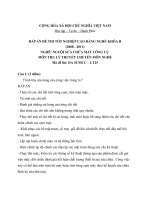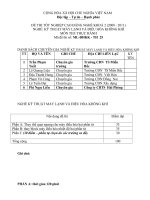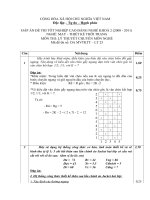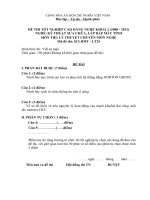Lecture Connections 25 | DNA Metabolism
Bạn đang xem bản rút gọn của tài liệu. Xem và tải ngay bản đầy đủ của tài liệu tại đây (4.6 MB, 67 trang )
Lecture Connections
25 | DNA Metabolism
© 2009 W. H. Freeman and Company
CHAPTER 25
DNA Metabolism
Key topics:
– DNA replication
– DNA repair
– DNA recombination
What is DNA Metabolism?
• While functioning as a stable storage of genetic
information, the structure of DNA is far from static:
– A new copy of DNA is synthesized with high fidelity before each
cell division
– Errors that arise during or after DNA synthesis are constantly
checked for, and repairs are made
– Segments of DNA are rearranged either within a chromosome
or between two DNA molecules giving offspring a novel DNA
• DNA metabolism consists of a set of enzyme catalyzed
and tightly regulated processes that achieve these tasks
The Substrate that Encodes its
Own Metabolisms
The Meselson-Stahl Experiment
• The Meselson-Stahl experiment was about the
origin of the two strands in each of the daughter
genomes
• Cells were grown on a medium containing only
15N isotope until all their DNA became fully 15N
labeled
• Cells were then switched to 14N medium and
allowed to divide once
• CsCl density gradient centrifugation was used to
determine the mass of genomic DNA before and
after each round of replication
DNA Replication is
Semiconservative
• The Meselson-Stahl experiment showed that the
nitrogen used for the synthesis of new dsDNA
becomes equally divided between the two
daughter genomes
• This suggests a semiconservative replication
mechanism
Replication of Circular DNA is
Bidirectional
• Both strands are replicated simultaneously
Synthesis of the Leading and
Lagging Strands
• Synthesis always occurs by addition of new
nucleotides to the 3’ end
• The leading strand is made continuously as the
replication fork advances
• The lagging strand is made discontinuously in
short pieces (Okazaki fragments) that are then
joined
DNA Elongation Chemistry
• Parental DNA strand serves as a template
• Nucleotide triphosphates serve as substrates in
strand synthesis
• Hydroxyl at the 3’ end of growing chain makes a
bond to the -phosphorus of nucleotide
• Pyrophosphate is a good leaving group
DNA Synthesis is Catalyzed by
DNA Polymerases
• Mg++ on the right coordinates to the -phosphate
and stabilize the negatively charged transition
state
Correct Geometry of Base Pairs
allows High Fidelity
Errors During the Synthesis are
Corrected by 3’ 5’ Exonuclease
Activity (1)
Errors During the Synthesis are
Corrected by 3’ 5’ Exonuclease
Activity (2)









